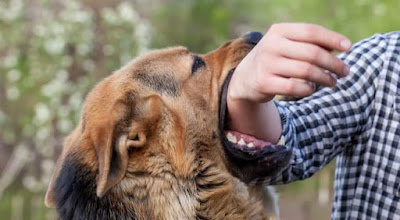What to Do After a Dog Bite
From the tiniest Min Pin to the largest of Great Danes, dogs come in all breeds and sizes. There are quiet and yappy dogs, lazy and active dogs, and passive and aggressive dogs. So, when someone lets the dogs out, and it results in you or a loved one getting bit, what do you do next?
 |
| What to Do After a Dog Bite |
Steps to Take After a Dog Bite
Step 1. Get to safety.
Whether it’s a rogue bite from a pet being played with or an attack from an unknown dog, remove your loved one’s presence from the dog. Use force if necessary, but be mindful not to get bit yourself. Dogs that are acting erratically or foaming at the mouth are likely to have rabies, and medical attention should be sought immediately.
Step 2. Evaluate the wound.
Is the wound a single bite, or is the wound deeper and larger? Is any bone exposed? Has your loved one lost the ability to function their limb or bend their fingers? If the wound is deep and covers a large or sensitive area, you should take your loved one to an emergency room. Other reasons to visit an emergency room post a dog bite include:
If you or they can’t remember when they’ve had a tetanus shot
If they feel weak, disoriented, or faint
If they are running a fever
Step 3. Ask About the Dog’s Vaccination History
If possible, ask the dog’s owner for their vaccination history. Have they had a rabies shot? If so, how long ago? Get the owner’s information – including name and telephone number. If the owner isn’t around, ask any nearby witnesses if they’re familiar with the dog or know where you could find the owner.
Step 4. Clean the wound.
If the wound is a single bite that has penetrated the skin, use soap and warm water to clean the area. Gently press on the area to promote a small amount of bleeding – this helps to flush out germs. Then, use an antibiotic and bandages to address the wound. If the dog hasn’t had their rabies shot, you should also visit an emergency room to prevent further issues.
If the wound is deep, covers a larger or sensitive area, or exposes bone, an emergency room will be able to clean, disinfect, and provide wound care. They’ll also be able to administer a rabies vaccine if you’re unsure of the dog’s vaccination history or know that the dog hasn’t had one.
How to Prevent Infection from a Dog Bite
Since dogs can introduce dangerous bacteria to your loved one’s body, it’s important that the wound is properly cleaned and taken care of. To keep wounds from becoming infected, you should:
- Use topical antibiotics in and around any broken skin.
- Change bandages daily
- Identify signs of infection before they spread
- Follow your doctor’s treatment plan – including taking antibiotics for the time prescribed
Complications of a Dog Bite
For any dog bite, you should monitor the wound for signs of infection until it’s fully healed. It may be a sign that the area is becoming infected if the wound is:
- Red
- Swollen
- Warm
- Tender
- Produces pus
Infection isn’t the only risk of a dog bite, however. Other complications may include:
- Rabies
- Tetanus
- Nerve and muscle damage
- Death
If the wound gets worse, your loved one experiences pain, or they develop a fever, you should visit the emergency care clinic immediately. A doctor will be able to provide antibiotics to treat infection and get your loved one back on the road to recovery.
